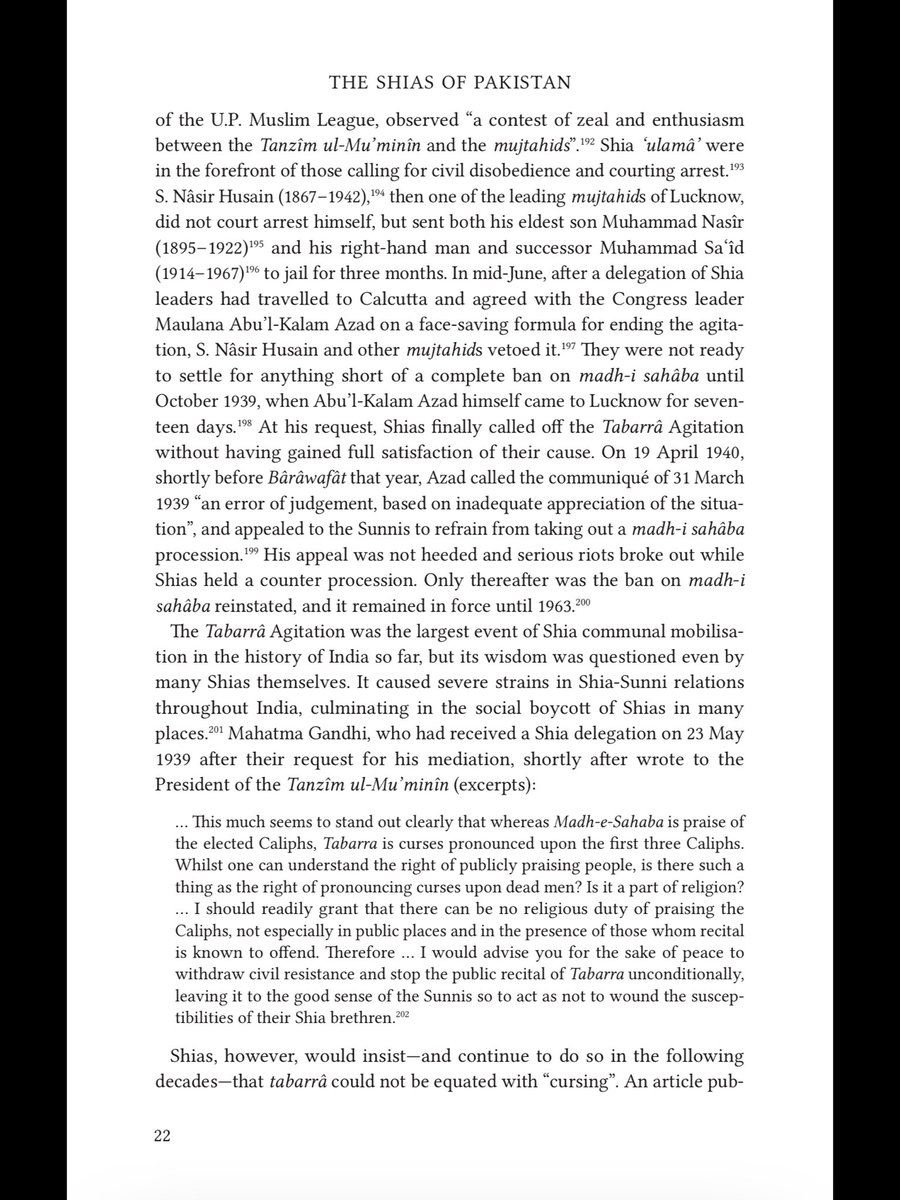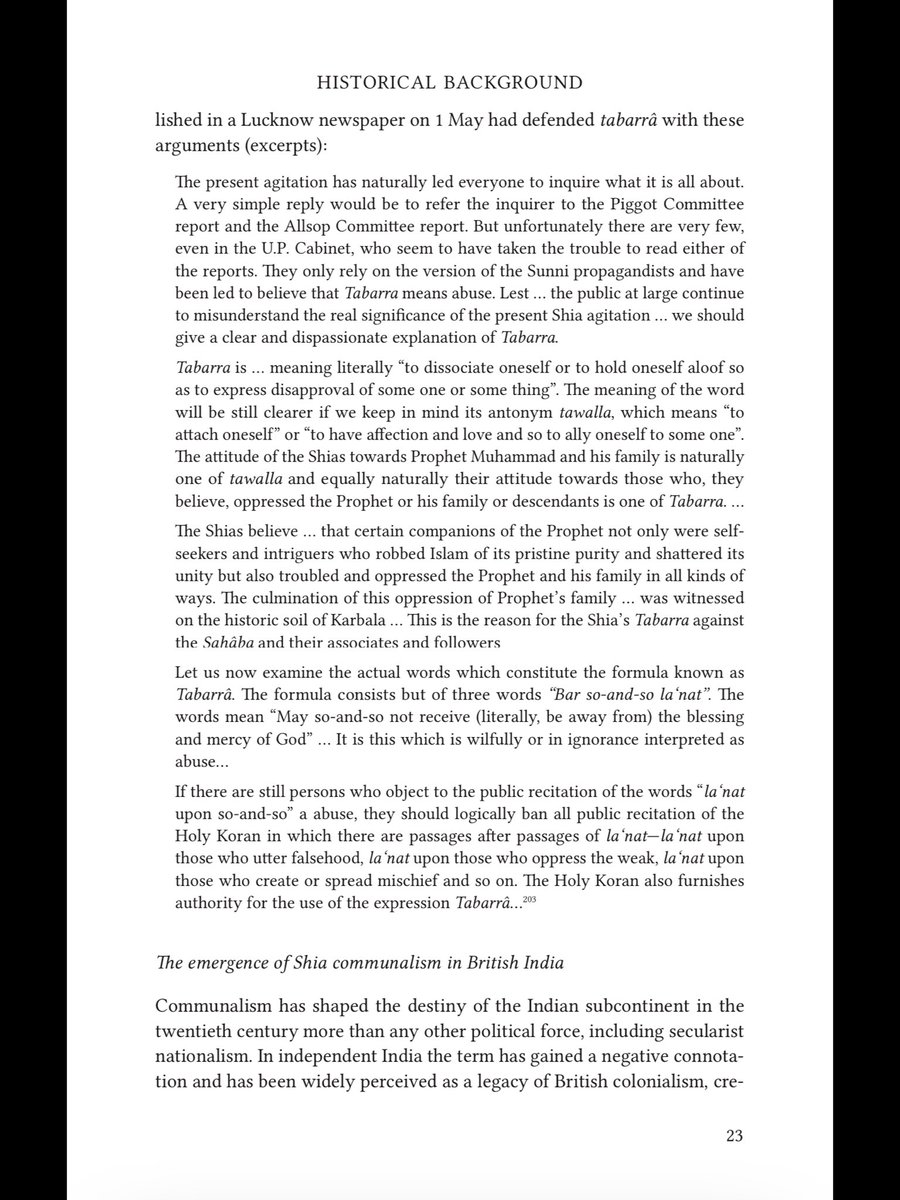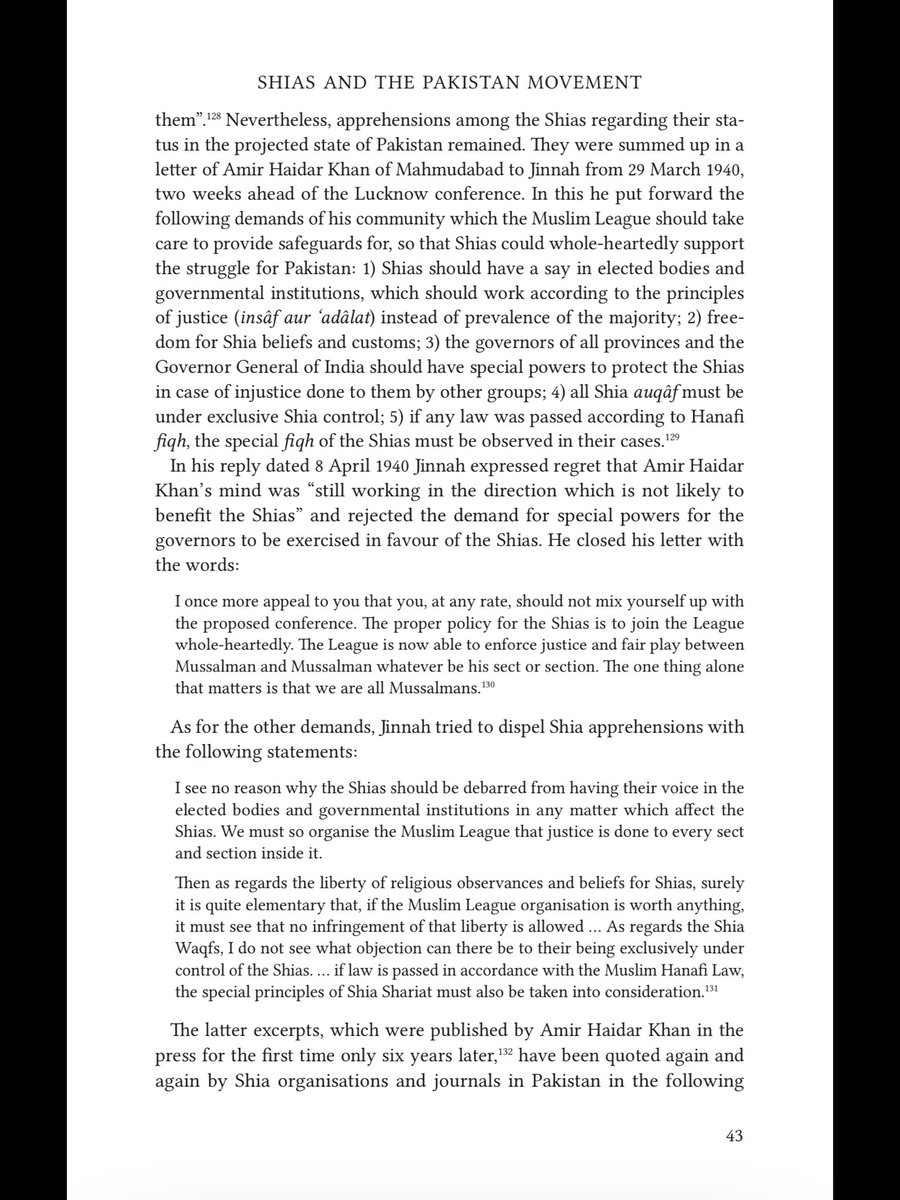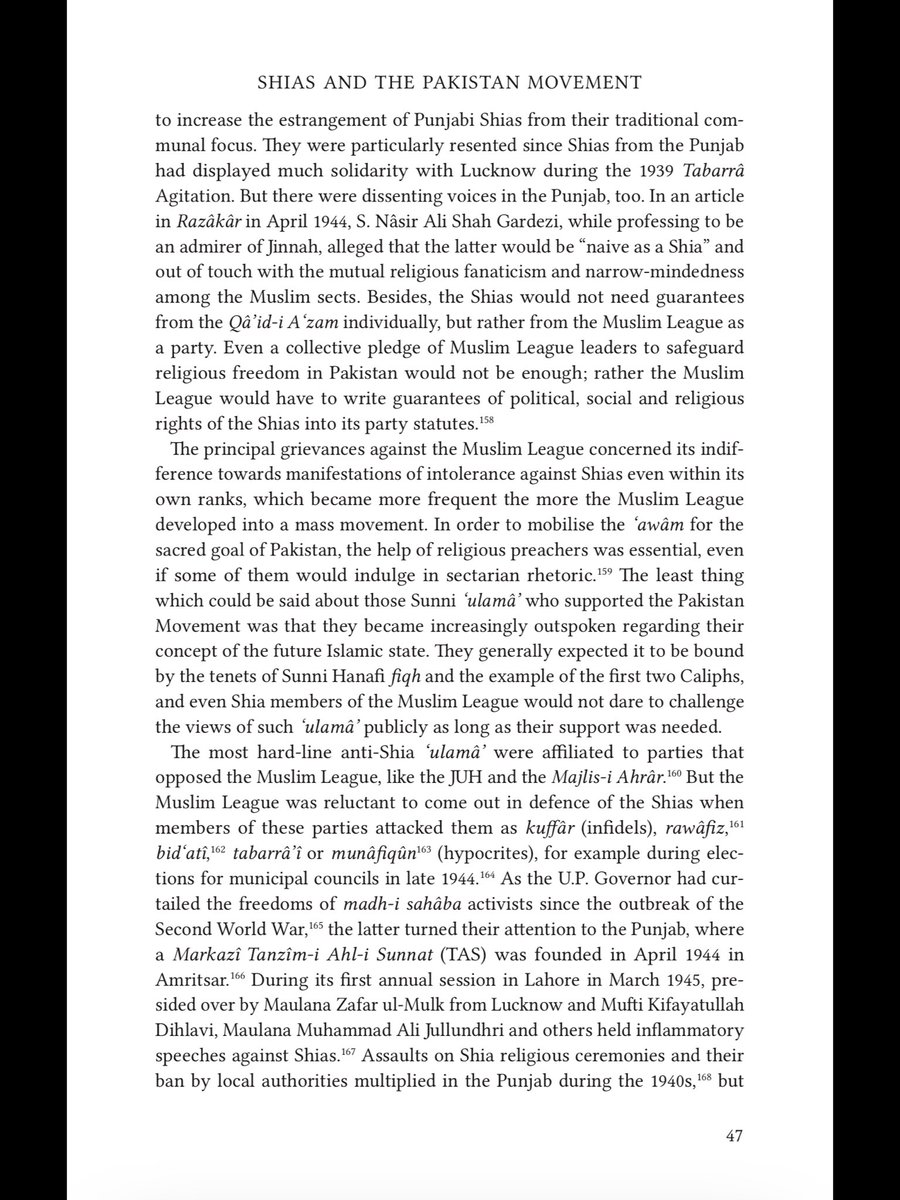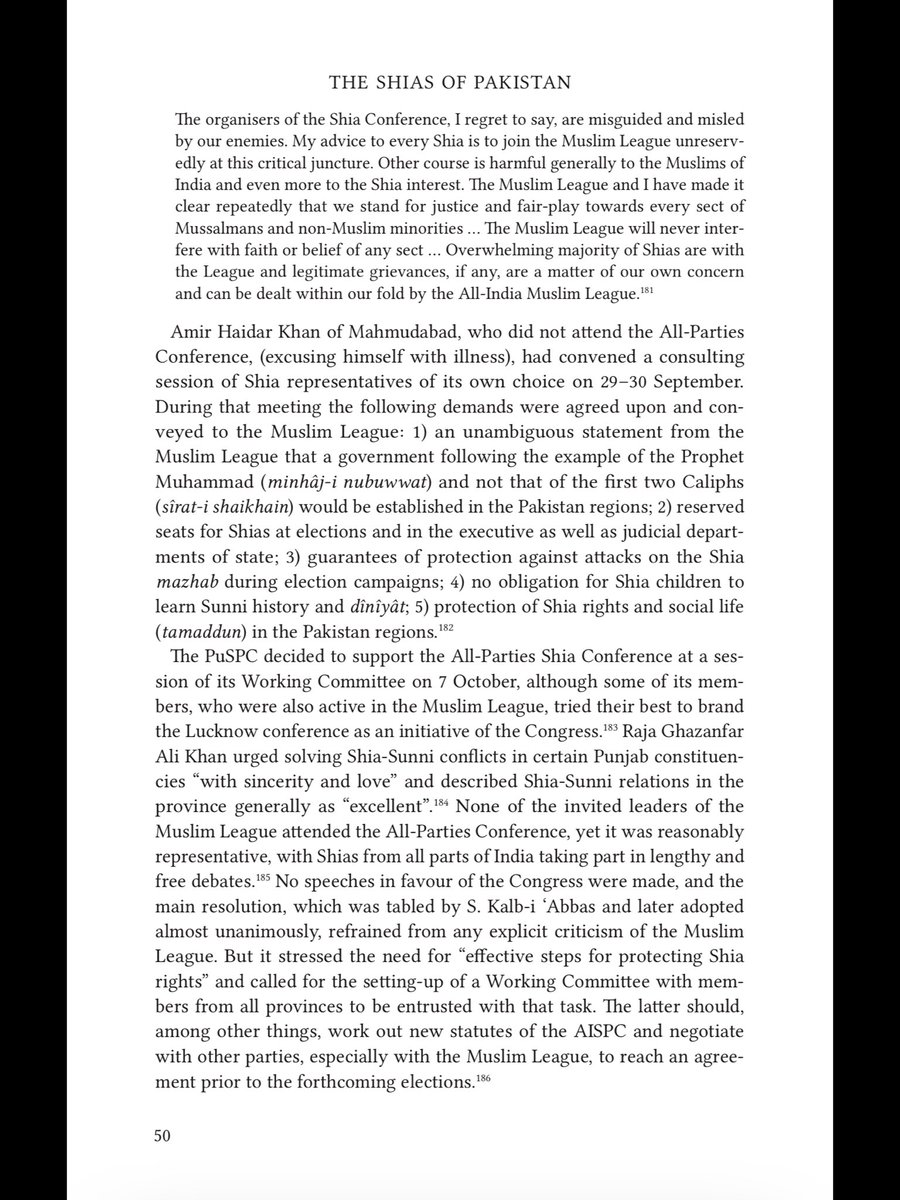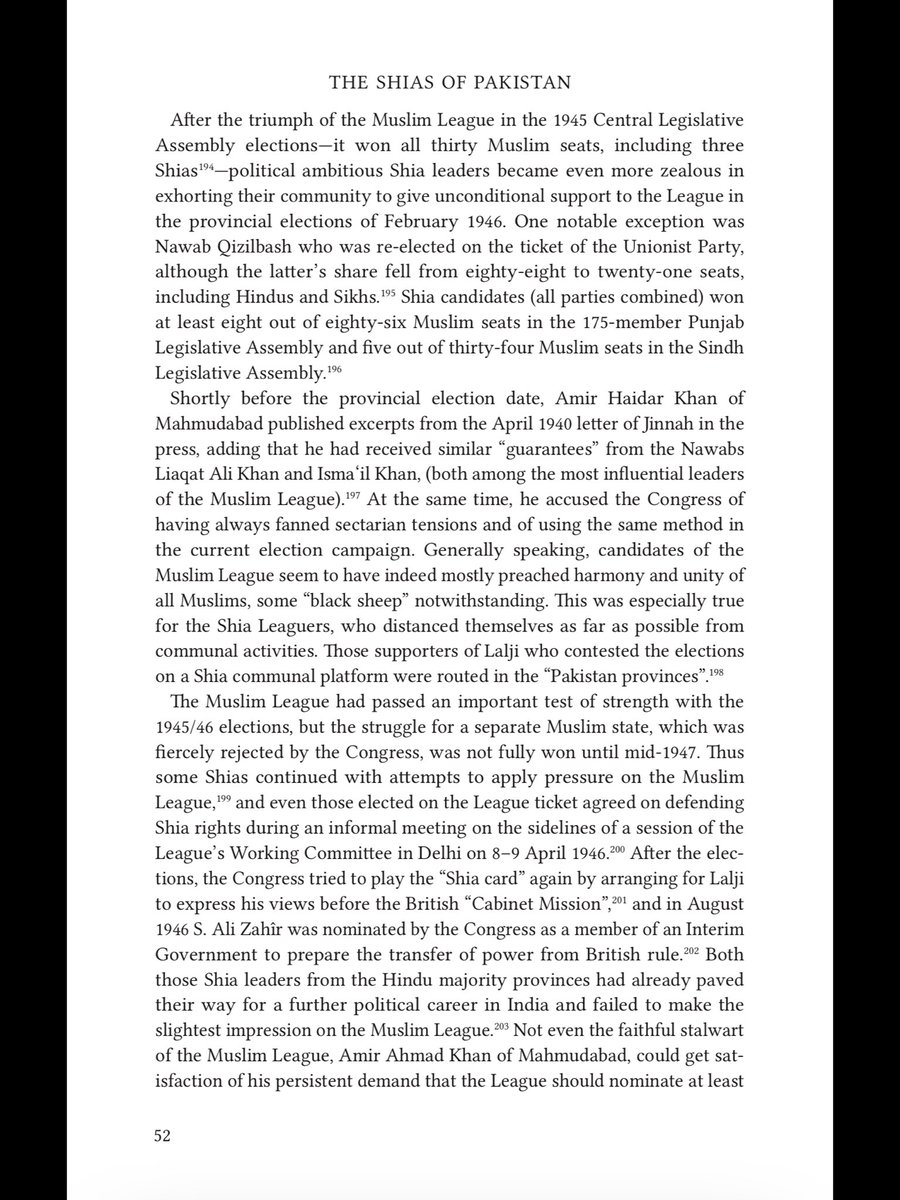Brief history of Shia-Sunni conflicts in South Asia (from Andreas Reick& #39;s The Shias of Pakistan: An Assertive and Beleaguered Minority): The first major polemical treatise against Shia doctrines, which has influenced many generations of Sunni ‘ulamâ’, was written by the famous > https://twitter.com/nayadaurpk/status/1260899492930498561">https://twitter.com/nayadaurp...
> scholar Shaikh Ahmad Sirhindi (1564–1624), revered by Sunni Muslims of the subcontinent as the Mujaddid-i Alf-i Thânî, around 1587. In his Radd al-rawâfiz, he clearly stated that Shias must be considered as kuffâr because of their cursing of ‘A’isha. Another anti-Shia book >
> widely read in India at that time was al-Nawâqiz fî’l-radd ‘alâ& #39;l-rawâfiz of Mirza Makhdumi, a former minister of the Iranian Shah Isma‘il Safavi II who had converted to Sunni beliefs. In 1587 Qazi Nurullah Shushtari wrote a rejoinder titled Masâ’ib un-nawâsib. Between 1561 >
> and 1579 Mullah Abdullah Ansari “Makhdum-ul-Mulk” and Shaikh Abd un-Nabiy used their position as Akbar’s central ministers (sadr us-sudûr) to have some prominent Shias executed under false pretexts, & in 1585 Mullah Ahmad Thattavi, a renown Shia ‘âlim in the service of Akbar, >
> was assassinated in Lahore. Four years later his
grave was dug up and his dead body burnt by fanatics. In his Masâ’ib un-nawâsib, Shushtari had defended the Shia practice of cursing (la‘n) of those among the ashâb who had been enemies of the ahl al-bait. Shaikh Ahmad Sirhindi >
grave was dug up and his dead body burnt by fanatics. In his Masâ’ib un-nawâsib, Shushtari had defended the Shia practice of cursing (la‘n) of those among the ashâb who had been enemies of the ahl al-bait. Shaikh Ahmad Sirhindi >
> in one of his letters sent to leading nobles demanded that “the company of innovators (Shias) should be avoided for they were worse than infidels, and to show them respect amounted to destroying Islam”. Shushtari, revered by Indian
Shias as the Shahîd-i Thâlith (Third Martyr) >
Shias as the Shahîd-i Thâlith (Third Martyr) >
> and most outstanding Shia ‘âlim in the history of the subcontinent, was awarded a punishment of flogging by Jehangir, during which he died in 1610. Under Aurangzeb, Muharram processions were banned and the Shia kingdoms in the Deccan were subjugated. A compendium of Hanafi >
> Islamic law prepared by Sunni ‘ulamâ’ on his orders, the Fatâwâ-i‘Alamgîrîya, declared Shias who cursed the first two Caliphs heretics. The most comprehensive refutation of Shia doctrines ever written in India was the Tuhfat-i ithnâ‘asharîya of Shah Waliyullah’s eldest son, >
> Shah Abdul-‘Azîz (1746–1824), which was completed in 1789. Syed Ahmed Barelwi toured north Indian towns from 1818 to 1821 with hundreds of followers preaching against Shia beliefs & practices. The main target of their attacks were ta‘zîya processions, which had become popular >
> among Sunnis as much as among Shias. Syed Ahmad repeatedly resorted to burning of ta‘zîyas, provoking riots in some cases. Muhammad Qasim Nanautavi (1833 77), founding director of Deoband seminary, wrote a summary of the Tuhfat-i ithnâ‘asharîya entitled Hidâyat ush-shî‘a. >
> The co-founder Rashid Gangohi (1829–1905) advised Sunnis to remain aloof from Muharram ceremonies & avoid prayer with Shias. Even Sir Syed Ahmed Khan translated 2 chapters of Tuhfat-i ithnâ‘asharîya into Urdu, followed by his Risâlat-i râh-i sunnat dar radd-i bid‘at (1850) >
> which criticised Shia traditions such as marâsî, ta‘zîya and ‘alam. Sir Syed’s successor as the head of the Aligarh College, S. Mahdi Ali Khan “Muhsin ul-Mulk” (1837–1907), had in 1870 published the reasons for his conversion from Shia to Sunni Islam in a widely-read book, >
> Âyât-i bayyanât. In Lucknow though, the Shia mujtahids, enjoying protection by the Awadh rulers, insisted on public cursing of the first three Caliphs. Ironically, in Lucknow Sunnis also used to take out ta‘zîyas in large numbers during Muharram, and Shia protested against >
> what they saw as the gradual transformation of Muharram into a “carnival” by local Sunnis. Thus in 1906, UP government assigned Sunnis a separate “Karbala” and a different procession route. However, Sunnis seized the opportunity to give a predominantly Sunni colour to their >
> procession and recited madh-i sahâba, i.e. praises for the first 4 Caliphs as “equal comrades” (châryâr). Shias retaliated by publicly reciting tabarrâ, i.e. curses upon the first 3 Caliphs. Serious riots broke out during Muharram in 1907 and 1908 when the same scenario was >
> repeated in Lucknow. In late 1908 U.P. Government appointed a committee headed by T. C. Piggot, which recommended to ban the recitation of madh-i sahâba on ‘Ashûrâ’, Chihlum & 21 Ramadan (the birthday of Ali Ibn Abi Talib) in public places, arguing that it was not a religious >
> tradition of the Sunnis, but an innovation highly offensive to Shias. It also recommended that Sunnis could obtain licences to recite madh-i sahâba on other days while Shias should be “restrained” from reciting tabarrâ. The government endorsed the Piggot Committee’s findings >
> in January 1909, and several attempts by Sunnis to get its decisions reviewed failed in the following years. It served as a catalyst for the convening of the first All-India Shia Conference in 1907. The situation was brought under control by strict enforcement of the ban on >
> madh-i sahâba processions at Shia commemorative days from 1912 till 1935. Shia-Sunni conflicts also cooled down as a result of growing anti-British sentiment among Indian Muslims from 1911 on, culminating in the Khilâfat Movement of 1919–23, and thereafter because of the >
> deterioration of Muslim-Hindu relations. In 1931 Maulana Abd ul-Shakur, who had already been the main instigator of the 1906–8 madh-i sahâba campaign, founded the Dâr ul-Muballighîn in Lucknow, a school entirely devoted to the training of anti-Shia munâzirs. At the same time, >
> the printing of polemical literature against ‘azâdârî increased considerably. In 1935 some Sunnis, incited by the Majlis-i Ahrâr-i Islâm, defied the long-standing ban & publicly recited madh-i sahâba on Chihlum. In the following year Sunnis applied for permission to take out >
> madh-i sahâba processions on the birthday of the Prophet Muhammad (Bârâwafât), and on being refused started a civil disobedience movement. In 1936–37 the situation further deteriorated, prompting the U.P. government to appoint another committee to review the recommendations >
> of 1908. In its report submitted in June 1937, the Allsop Committee recognised the theoretical right of the Sunnis to recite madh-i sahâba but recommended to uphold the ban in Lucknow, because the intention was clearly to provoke the Shias. When the report was made public in >
> March 1938, Sunni indignation became more widespread. Maulana Abd ul-Shakur declared madh-i sahâba a religious duty (wâjib) wherever it was banned, and Maulana Husain Ahmad Madani, leader of the Jam‘îyat al-‘Ulamâ’-i Hind (JUH), joined the calls for civil disobedience. The >
> conflict came to a head in March 1939, when the Majlis-i Ahrâr brought thousands of its followers to Lucknow to start another round of agitation. On 31 March the Congress-led U.P. Government issued a communiqué, stating that Sunnis would be allowed to recite madh-i sahâba in >
> public meetings and processions every year on Bârâwafât day (which fell on 3 May that year). The decision was made with a view to keep the JUH and the Majlis-i Ahrâr in the Congress camp, deepen intra-Muslim cleavages and thus weaken the Muslim League, but the vehemence of >
> Shia reactions took everybody by surprise. [This has already become longer than I expected. Rest later :) But in short, Muslim League was happy to use sectarian sunni ulema and didn& #39;t care enough to allay the concerns of the Shia leaders].
> What followed were Shia Sunni clashes in Lucknow, resulting in curfew & arrests. This was the beginning of what became known as the Tabarrâ Agitation, still the largest event of Shia communal mobilization in the history of India, a civil disobedience movement that continued >
> for 6 to 7 months, 17,000 to 18,000 Shia from all over India congregated in Lucknow insisting on reciting tabarrâ to the chagrin of Sunni groups. One group of Shia leaders went to Calcutta to ask Maulana Abu’l-Kalam Azad to intervene but local mujtahids vetoed it. Finally, he >
> came to Lucknow himself, & at his request, Shias finally called off the Tabarrâ Agitation, though later Maulana Azad called his intervention a mistake. The agitation had caused severe strains in Shia-Sunni relations throughout India, culminating in the social boycott of Shias >
> in many places. Mahatma Gandhi, who had received a Shia delegation on 23 May 1939 after their request for his mediation, shortly after wrote to the President of the Tanzîm ul-Mu’minîn, requesting a stop to tabarrâ recitations. >
> Shias insisted that that tabarrâ could not be equated with “cursing”. An article published in a Lucknow newspaper defended tabarrâ arguing that it is merely a deliberate distancing of themselves from certain companions of prophet who oppressed the prophet & his family. >
> As the Pakistan Movement gained momentum, though most Shia were in support, there was also an obvious anxiety on their status in a Sunni majority Pakistan. These were summed up in a letter of Amir Haidar Khan of Mahmudabad to Jinnah from 29 March 1940. The letter demanded >
> the sort of status & constitutional rights that Jinnah had demanded from India, separate electorates & legislative powers, but Jinnah rebuffed them. His response sort of echoes Nehru’s one India for all Indians: “The League is now able to enforce justice and fair play between >
> Mussalman & Mussalman whatever be his sect or section. The one thing alone that matters is that we are all Mussalmans.” Yet Muslim League actively procured the help of Sunni ulema, including the sectarian ones. These ulema became increasingly outspoken regarding their concept >
> of the future Islamic state bound by the tenets of Sunni Hanafi fiqh and the example of the first two Caliphs. Muslim League was reluctant to come out in defence of the Shias when members of these parties attacked them as kuffâr, rawâfiz, bid‘atî, tabarrâ’î or munâfiqûn, for >
> example during elections for municipal councils in late 1944. The Sipah-e-Sahaba phenomenon isn’t anything new in Punjab, typically blamed on Zia, in 1944 a Markazî Tanzîm-i Ahl-i Sunnat (TAS) was founded in Amritsar. During its first annual session in Lahore in March 1945, >
> presided over by Maulana Zafar ul-Mulk from Lucknow & Mufti Kifayatullah Dihlavi, Maulana Muhammad Ali Jullundhri & others held inflammatory speeches against Shias. Assaults on Shia religious ceremonies & their ban by local authorities multiplied in Punjab during the 1940s, >
> but neither the Muslim League nor, for that matter, Shia members of the Punjab Legislative Assembly, paid much attention to continuous protests by the Shia organisations and media. On 25 July 1944 Syed Ali Zahîr wrote a letter to Jinnah demanding a ban on sectarian propaganda >
> against Shias during elections & guarantees for sufficient representation of Shias. In response, Jinnah warned of “improper” & “illogical” attempts to create divisions within the Muslim camp. In April 1945, Husainbhai Lalji, a Khoja Twelver Shia leader & merchant from Bombay,>
> claimed that the Shias would no longer trust the sense of justice of the Sunni majority, & later warned of the danger of “gradual annihilation” of Shias because of Sunni fanaticism in Pakistan. His memorandum gained wide support among the Shias, including the PuSC president >
> Nawab Ihsan Ali Khan who expressed his fear that there would be no protection of Shia rights in Pakistan. The demand for separate electorates for Shias was also supported by Razâkâr, which deplored the inability of the 14 Shia deputies in the Punjab Assembly to raise their >
> voices for any Shia grievance out of fear to loose their seats in the coming elections. As ML gained mass-appeal, more & more Shia leaders became its unconditional supporters. One example was Shaikh Karamat Ali from Sheikhupura, who had been President of the PuSC from 1938 to >
> 1940 & Vice-President since October 1943, & who had legally defended Shias arrested in the course of agitation in Qasur in 1938 & 1939 free of cost. During his election campaign of late 1945 on a ML ticket he took pains to make his Shia identity almost unrecognisable, denying >
> even that “any Shia could feel ill-will against the ashâb-i thalâtha” (the first three Caliphs). OTOH Sunni ‘ulamâ’ within the ML became more outspoken. For eg, Maulana Zafar Ahmad ‘Usmani published a fatwâ in the League daily al-Manshûr (Delhi), justifying the inclusion of >
> Shias in the League with the argument that Sunnis could cooperate with khawârij heretics during their confrontation with idolaters (i.e. the Hindus), because even khawârij would fight for Islam and against kufr. His colleague Maulana S. Nasîr ul-Haqq was quoted in Nawâ-i Waqt >
> on 3 November 1945 with the verdict that according to the Prophet only those who followed the path of the khulafâ’-i râshidûn were on the right path, whereas all other groups, parties or sects would be “a work of Satan”. Needless to say, no disciplinary action was taken by >
> the ML against such party members. Even Maulana Mazhar Ali Azhar, the founder and leader of Majlis-e-Ahrar-ul-Islam, & who had coined the insult Kâfir-i A‘zam for Jinnah now headed a faction of the Ahrâr that supported the ML. The pro-Congress group of the Ahrâr was led by >
> the Maulanas Habib ur-Rahman Ludhianvi & Syed Da’ud Ghaznavi. The JUH turned against the ML shortly after the 1937 elections & strengthened its ties with the Congress which dated back to its foundation in 1919. Some prominent ‘ulamâ’ split from the party in subsequent years, >
> but the majority of the Deobandi & Ahl-i hadîth clergy remained opposed to Jinnah & the Pakistan Movement until 1947. Amir Ahmad Khan of Mahmudabad, who along with his father was one of the earliest & most prominent financier & supporter of Jinnah & ML, gave his resignation >
> when his persistent demand that the League should nominate at least one Shia ‘âlim for the Constituent Assembly wasn’t met. On 3 June 1947 when a Constituent Assembly of Pakistan was formed, the League appointed a 7-member subcommittee of specialists to advise the Assembly on >
> matters concerning the implementation of the Islamic sharî‘a, all of whom were Sunnis. Likewise, three Sunni ‘ulamâ’ but no Shia ‘âlim were appointed for the Constituent Assembly. End.

 Read on Twitter
Read on Twitter
